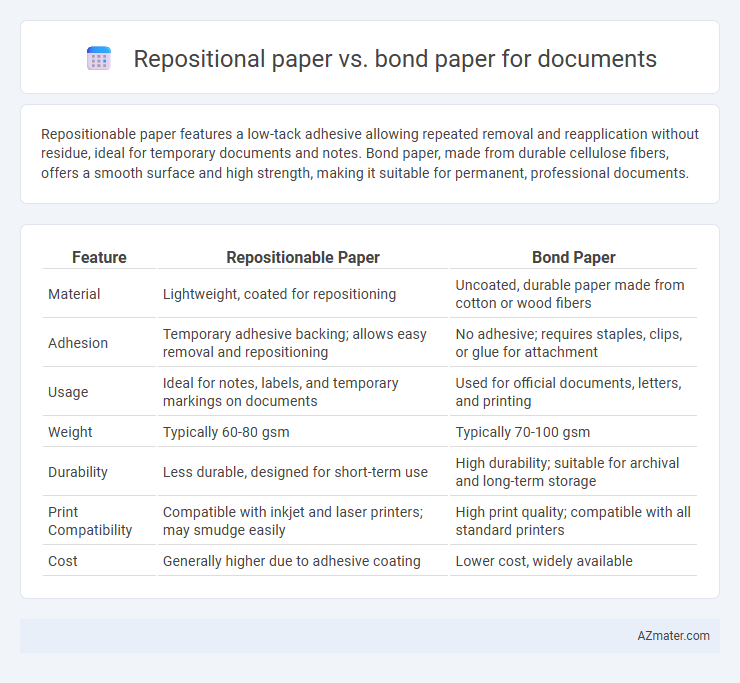Repositionable paper features a low-tack adhesive allowing repeated removal and reapplication without residue, ideal for temporary documents and notes. Bond paper, made from durable cellulose fibers, offers a smooth surface and high strength, making it suitable for permanent, professional documents.
Table of Comparison
| Feature | Repositionable Paper | Bond Paper |
|---|---|---|
| Material | Lightweight, coated for repositioning | Uncoated, durable paper made from cotton or wood fibers |
| Adhesion | Temporary adhesive backing; allows easy removal and repositioning | No adhesive; requires staples, clips, or glue for attachment |
| Usage | Ideal for notes, labels, and temporary markings on documents | Used for official documents, letters, and printing |
| Weight | Typically 60-80 gsm | Typically 70-100 gsm |
| Durability | Less durable, designed for short-term use | High durability; suitable for archival and long-term storage |
| Print Compatibility | Compatible with inkjet and laser printers; may smudge easily | High print quality; compatible with all standard printers |
| Cost | Generally higher due to adhesive coating | Lower cost, widely available |
Introduction to Repositional and Bond Paper
Repositional paper features a pressure-sensitive adhesive that allows temporary sticking and easy repositioning without residue, making it ideal for drafts, annotations, and planning documents. Bond paper is a durable, high-quality writing paper used for official documents, correspondence, and printing, known for its strength and smooth surface. Choosing between repositional and bond paper depends on the need for flexibility in placement versus permanence and professional presentation.
What is Repositional Paper?
Repositional paper is a type of adhesive paper designed to be temporarily stuck and easily removed or repositioned without leaving residue, making it ideal for annotations, labeling, and temporary notices on documents. Unlike bond paper, which is a standard, non-adhesive writing material commonly used for printing and official documents, repositional paper allows for flexible placement and reuse on various surfaces. Its unique adhesive properties enhance workflow efficiency by enabling users to move notes or labels as needed without damaging the underlying document.
What is Bond Paper?
Bond paper is a high-quality, durable writing paper commonly used for official documents, letters, and stationery, recognized for its strength and smooth texture. It typically contains rag or cotton fiber content, which enhances its durability and resistance to wear, making it ideal for important records and printing needs. Compared to repositionable paper, bond paper offers a more permanent, professional finish suitable for archival purposes and formal communications.
Key Differences Between Repositional and Bond Paper
Repositional paper features a low-tack adhesive on one side, allowing documents to be temporarily attached and easily repositioned without damage, making it ideal for annotations and reminders. Bond paper, commonly used for official documents and printing, is a durable, non-adhesive paper known for its high-quality texture and strength, ensuring long-lasting, professional presentations. The primary difference lies in repositional paper's adhesive backing for flexibility versus bond paper's smooth, non-sticky surface designed for permanence.
Print Quality Comparison
Repositional paper offers moderate print quality with its temporary adhesive backing, ideal for drafts and notes without smudging or ink bleed, while bond paper provides superior print clarity and sharpness, making it suitable for official documents and professional presentations. Bond paper's smooth surface enhances ink absorption and color vibrancy, resulting in crisp text and images that maintain longevity without fading. Repositional paper may slightly compromise print resolution due to its textured surface and adhesive layer, limiting its effectiveness for high-quality printing needs.
Durability and Longevity
Repositional paper features a low-tack adhesive allowing temporary placement without tearing, making it less durable for long-term document preservation. Bond paper, typically made from higher-quality fibers with a denser composition, offers superior durability and resistance to wear, ideal for documents requiring longevity. For archival or frequently handled documents, bond paper provides enhanced structural integrity and lifespan compared to repositional paper.
Cost Analysis
Repositional paper generally incurs higher costs due to its adhesive backing material and specialized manufacturing process, while bond paper is more cost-effective and widely available for standard document printing. The price difference significantly impacts bulk purchasing decisions, with bond paper favored for high-volume projects due to its economical pricing and adequate quality. Businesses prioritizing budget efficiency often choose bond paper to minimize expenses without compromising on basic document clarity and durability.
Environmental Impact
Repositional paper typically uses less adhesive and is designed for multiple uses, reducing overall waste compared to traditional bond paper, which is often single-use and generates more paper waste. Bond paper production generally consumes more water and energy, contributing to a higher carbon footprint, whereas many repositional papers are made with recycled fibers and eco-friendly adhesives, enhancing their sustainability profile. Choosing repositional paper over bond paper can significantly lower environmental impact through reduced resource consumption and minimized landfill contributions.
Best Uses for Repositional vs Bond Paper
Repositional paper is ideal for temporary notes, labels, and documents that require easy removal and reapplication without residue, making it perfect for planners, reminders, and drafts. Bond paper, known for its durability and smooth finish, is suited for official documents, reports, and printed materials that need to withstand frequent handling and archival storage. Choosing repositional paper enhances flexibility in document management, while bond paper ensures longevity and professional presentation.
Choosing the Right Paper for Your Documents
Repositional paper offers the advantage of easy removal and repositioning without leaving residue, making it ideal for temporary notes or drafts in document workflows. Bond paper, known for its durability and professional appearance, suits formal documents requiring permanence and frequent handling. Selecting the right paper depends on the document's purpose, with repositional paper enhancing flexibility and bond paper ensuring longevity and a polished finish.

Infographic: Repositional paper vs Bond paper for Document
 azmater.com
azmater.com